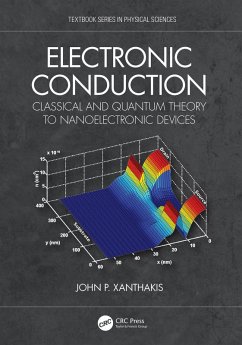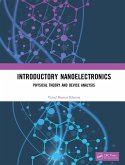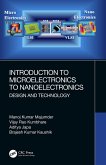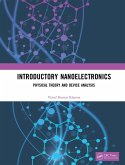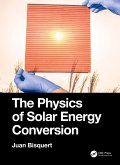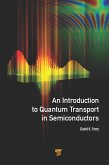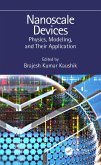Electronic Conduction (eBook, ePUB)
Classical and Quantum Theory to Nanoelectronic Devices
Sofort per Download lieferbar

Electronic Conduction (eBook, ePUB)
Classical and Quantum Theory to Nanoelectronic Devices
- Format: ePub
- Merkliste
- Auf die Merkliste
- Bewerten Bewerten
- Teilen
- Produkt teilen
- Produkterinnerung
- Produkterinnerung

Hier können Sie sich einloggen

Bitte loggen Sie sich zunächst in Ihr Kundenkonto ein oder registrieren Sie sich bei bücher.de, um das eBook-Abo tolino select nutzen zu können.
Electronic Conduction: Classical and Quantum Theory to Nanoelectronic Devices provides a concise, complete introduction to the fundamental principles of electronic conduction in microelectronic and nanoelectronic devices, with an emphasis on integrating the quantum aspects of conduction.
The chapter coverage begins by presenting the classical theory of conduction, including introductory chapters on quantum mechanics and the solid state, then moving to a complete presentation of essential theory for understanding modern electronic devices. The author's unique approach is applicable to…mehr
- Geräte: eReader
- mit Kopierschutz
- eBook Hilfe
![Electronic Conduction (eBook, PDF) Electronic Conduction (eBook, PDF)]() John P. XanthakisElectronic Conduction (eBook, PDF)47,95 €
John P. XanthakisElectronic Conduction (eBook, PDF)47,95 €![Introductory Nanoelectronics (eBook, ePUB) Introductory Nanoelectronics (eBook, ePUB)]() Vinod Kumar KhannaIntroductory Nanoelectronics (eBook, ePUB)41,95 €
Vinod Kumar KhannaIntroductory Nanoelectronics (eBook, ePUB)41,95 €![Introduction to Microelectronics to Nanoelectronics (eBook, ePUB) Introduction to Microelectronics to Nanoelectronics (eBook, ePUB)]() Manoj Kumar MajumderIntroduction to Microelectronics to Nanoelectronics (eBook, ePUB)45,95 €
Manoj Kumar MajumderIntroduction to Microelectronics to Nanoelectronics (eBook, ePUB)45,95 €![Introductory Nanoelectronics (eBook, PDF) Introductory Nanoelectronics (eBook, PDF)]() Vinod Kumar KhannaIntroductory Nanoelectronics (eBook, PDF)41,95 €
Vinod Kumar KhannaIntroductory Nanoelectronics (eBook, PDF)41,95 €![The Physics of Solar Energy Conversion (eBook, ePUB) The Physics of Solar Energy Conversion (eBook, ePUB)]() Juan BisquertThe Physics of Solar Energy Conversion (eBook, ePUB)109,95 €
Juan BisquertThe Physics of Solar Energy Conversion (eBook, ePUB)109,95 €![An Introduction to Quantum Transport in Semiconductors (eBook, ePUB) An Introduction to Quantum Transport in Semiconductors (eBook, ePUB)]() David K. FerryAn Introduction to Quantum Transport in Semiconductors (eBook, ePUB)94,95 €
David K. FerryAn Introduction to Quantum Transport in Semiconductors (eBook, ePUB)94,95 €![Nanoscale Devices (eBook, ePUB) Nanoscale Devices (eBook, ePUB)]() Brajesh Kumar KaushikNanoscale Devices (eBook, ePUB)42,95 €
Brajesh Kumar KaushikNanoscale Devices (eBook, ePUB)42,95 €-
-
-
The chapter coverage begins by presenting the classical theory of conduction, including introductory chapters on quantum mechanics and the solid state, then moving to a complete presentation of essential theory for understanding modern electronic devices. The author's unique approach is applicable to microscale and nanoscale device simulation, which is particularly timely given the explosion in the nanoelectronics field.
Features
- Self-contained
- Gives a complete account of classical and quantum aspects of conduction in nanometer scale devices
- Emphasises core principles, the book can be useful to electrical engineers and material scientists, and no prior course in semiconductors is necessary
- Highlights the bridge to modern electronics, first presenting the physics, and then the engineering complications related to quantum behaviour
- Includes many clear, illustrative diagrams and chapter problem sets
- Gives an account of post-Silicon devices such as the GaAs MOSFET, the CNT-FET and the vacuum transistor
- Showcases why quantum mechanics is necessary with modern devices due to their size and corresponding electron transport properties
- Discusses all the issues that will enable readers to conduct their own research
Dieser Download kann aus rechtlichen Gründen nur mit Rechnungsadresse in A, B, BG, CY, CZ, D, DK, EW, E, FIN, F, GR, HR, H, IRL, I, LT, L, LR, M, NL, PL, P, R, S, SLO, SK ausgeliefert werden.
- Produktdetails
- Verlag: Taylor & Francis eBooks
- Seitenzahl: 310
- Erscheinungstermin: 14. Dezember 2020
- Englisch
- ISBN-13: 9780429014338
- Artikelnr.: 60439553
- Verlag: Taylor & Francis eBooks
- Seitenzahl: 310
- Erscheinungstermin: 14. Dezember 2020
- Englisch
- ISBN-13: 9780429014338
- Artikelnr.: 60439553
- Herstellerkennzeichnung Die Herstellerinformationen sind derzeit nicht verfügbar.
1. Quantum Mechanics. 1.1. The two-slit experiment. 1.2. The Schroedinger
Equation. 1.3. Particle in a Rectangular Quantum Box. 1.4. Heisenberg's
Uncertainty Principle. 1.5. The Pauli Principle and the Fermi Dirac
Probability. 1.6. The Hydrogen atom and the atoms of the Periodic Table.
1.7. Barrier Penetration and Tunneling. 1.8. Probability Current Density.
2. Electron States in Solids. 2.1. Qualitative Description of Energy Bands
in Solids. 2.2. The k-space and Bloch's Theorem. 2.3. The LCAO method. 2.4.
Quick Revision of the concept of a Hole and Doping. 2.5. Velocity of
electrons in Solids. 2.6. The concept of Effective Mass. 2.7. Concentration
of Carriers in Semiconductors and Metals. 2.8. The Effective Mass Equation.
II. Theory Of Conduction. 3. Simple Classical Theory of Conduction. 3.1.
External voltages and Fermi levels. 3.2. Collisions and drift mobility.
3.3. Mechanisms of scattering. 3.4. Recombination of carriers. 3.5
Diffusion Current. 3.6. Continuity Equations. 3.7. The ideal PN junction at
equilibrium. 3.8. The ideal PN junction under bias. 3.9. The non-ideal PN
junction. 3.10. The Metal-Semiconductor or Schottky junction. 4. Advanced
Classical Theory of conduction. 4.1. The need for a better classical theory
of conduction. 4.2. The Boltzman equation. 4.3. Solution of the Boltzman
equation by the relaxation time approximation. 4.4. Application of an
Electric Field. 4.5. Diffusion Currents. 4.6. General Expression for the
Current Density. 4.7. The Seebeck-Thermoelectric Effect. 4.8. Saturation of
drift velocity. 4.9. The Gunn Effect and velocity overshoot. 4.10. The
classical Hall Effect. Chapter 5. The Quantum Theory of Conduction. 5.1.
Critique of the Boltzmann Equation and Regimes of conduction. 5.2.
Electronic Structure of Low-dimensional Systems. 5.3. The Landauer
Formalism. 5.4. The Effective Mass Equation for Heterostructures. 5.5.
Transmission Matrices and Airy Function. 5.6. The Resonant Tunneling Diode
RTD. III. Devices. Chapter 6: Field Emission and Vacuum Devices. 6.1.
Introduction. 6.2. The One-dimensional WKB Equation. 6.3. Field Emission
from Planar Surfaces. 6.4. The Three-dimensional WKB Problem. 6.5. Field
Emission from Curved Surfaces. 6.6. The Vacuum Transistor. Chapter 7. The
MOSFET. 7.1. Basic Operation. 7.2. Simple Classical Theory of the MOSFET.
7.3. Advanced Classical Theory of the MOSFET. 7.4. Quantum Theory of the
MOSFET. 7.5. Time-Dependent Performance and Moores' law. 7.6. Non-Planar Si
MOSFETs and the FinFET. Chapter 8. Post -Si FETs. 8.1. Introduction. 8.2.
Simple Theory of the HEMT or MODFET. 8.3. Advanced theory of the HEMT. 8.4.
The III-V MOSFET. 8.5. The Carbon Nanotube FET, CNTFET. Appendices. A1.
Angular Momentum and Spin. A2. Lattice Vibrations. A3. Calculation of
Impurity States in Semiconductors. A4. Direct and Indirect Gap
Semiconductors and Optical Properties.
1. Quantum Mechanics. 1.1. The two-slit experiment. 1.2. The Schroedinger
Equation. 1.3. Particle in a Rectangular Quantum Box. 1.4. Heisenberg's
Uncertainty Principle. 1.5. The Pauli Principle and the Fermi Dirac
Probability. 1.6. The Hydrogen atom and the atoms of the Periodic Table.
1.7. Barrier Penetration and Tunneling. 1.8. Probability Current Density.
2. Electron States in Solids. 2.1. Qualitative Description of Energy Bands
in Solids. 2.2. The k-space and Bloch's Theorem. 2.3. The LCAO method. 2.4.
Quick Revision of the concept of a Hole and Doping. 2.5. Velocity of
electrons in Solids. 2.6. The concept of Effective Mass. 2.7. Concentration
of Carriers in Semiconductors and Metals. 2.8. The Effective Mass Equation.
II. Theory Of Conduction. 3. Simple Classical Theory of Conduction. 3.1.
External voltages and Fermi levels. 3.2. Collisions and drift mobility.
3.3. Mechanisms of scattering. 3.4. Recombination of carriers. 3.5
Diffusion Current. 3.6. Continuity Equations. 3.7. The ideal PN junction at
equilibrium. 3.8. The ideal PN junction under bias. 3.9. The non-ideal PN
junction. 3.10. The Metal-Semiconductor or Schottky junction. 4. Advanced
Classical Theory of conduction. 4.1. The need for a better classical theory
of conduction. 4.2. The Boltzman equation. 4.3. Solution of the Boltzman
equation by the relaxation time approximation. 4.4. Application of an
Electric Field. 4.5. Diffusion Currents. 4.6. General Expression for the
Current Density. 4.7. The Seebeck-Thermoelectric Effect. 4.8. Saturation of
drift velocity. 4.9. The Gunn Effect and velocity overshoot. 4.10. The
classical Hall Effect. Chapter 5. The Quantum Theory of Conduction. 5.1.
Critique of the Boltzmann Equation and Regimes of conduction. 5.2.
Electronic Structure of Low-dimensional Systems. 5.3. The Landauer
Formalism. 5.4. The Effective Mass Equation for Heterostructures. 5.5.
Transmission Matrices and Airy Function. 5.6. The Resonant Tunneling Diode
RTD. III. Devices. Chapter 6: Field Emission and Vacuum Devices. 6.1.
Introduction. 6.2. The One-dimensional WKB Equation. 6.3. Field Emission
from Planar Surfaces. 6.4. The Three-dimensional WKB Problem. 6.5. Field
Emission from Curved Surfaces. 6.6. The Vacuum Transistor. Chapter 7. The
MOSFET. 7.1. Basic Operation. 7.2. Simple Classical Theory of the MOSFET.
7.3. Advanced Classical Theory of the MOSFET. 7.4. Quantum Theory of the
MOSFET. 7.5. Time-Dependent Performance and Moores' law. 7.6. Non-Planar Si
MOSFETs and the FinFET. Chapter 8. Post -Si FETs. 8.1. Introduction. 8.2.
Simple Theory of the HEMT or MODFET. 8.3. Advanced theory of the HEMT. 8.4.
The III-V MOSFET. 8.5. The Carbon Nanotube FET, CNTFET. Appendices. A1.
Angular Momentum and Spin. A2. Lattice Vibrations. A3. Calculation of
Impurity States in Semiconductors. A4. Direct and Indirect Gap
Semiconductors and Optical Properties.
